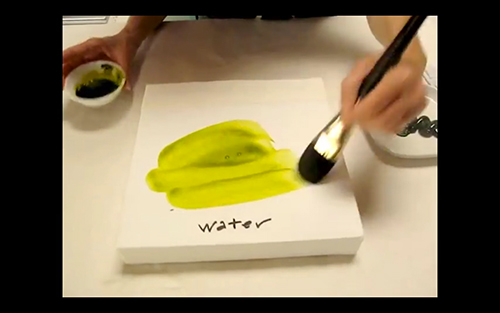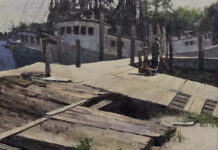A video that a San Francisco artist posted on YouTube about the alleged dangers of toning a canvas with too thin of a mixture of acrylic paint was recently making the rounds on social media, so PleinAir Today asked some experts for their advice.
Lead Image: Michele Theberge posted a video warning of the dangers of toning a surface with acrylic paints diluted too much.
Michele Theberge posted a video titled “Worst Mistake Acrylic Painters Make” in which she explains that toning a canvas with acrylic paint thinned too far creates a situation called underbinding, allowing further paint application to just peel off. Decidedly unarchival, it would seem.
Theberge recommended using an acrylic airbrush painting medium to thin the pigment, rather than water. Her advice seemed important, considering how most plein air painters work on a toned surface. But how well does Theberge’s science hold up? We turned to the experts at Golden Artist Colors, one of the most respected names in the paint world and in particular the world of acrylic paints, for a critique of Theberge’s video. Sarah Sands, the senior technical specialist in Golden’s Product Support Department, responded.
“The video is very much a mixed bag,” says Sands. “We assume it is aimed at artists using a broad range of acrylics, including potentially ones that are student-grade or marketed for crafts. If true, then her advice of limiting water additions to 30 percent — while much more conservative than we would recommend for our own products — might be a well-intentioned attempt to err greatly on the side of caution, given the range of quality the audience might work with. However, we have repeatedly found ourselves having to counter unfounded fears of using water to thin acrylics, and this video unfortunately further plays into that.

“Speaking of our own acrylics, with a few exceptions such as High Flow, OPEN, and Acrylic Gesso, we generally state that you can safely thin our regular acrylics and mediums/gels up to 1:1 with water and still get a strong, good film. This is something we have tested repeatedly on non-absorbent surfaces such as Plexiglas, which would of course be a strenuous test of film strength and adhesion. And in fact the paints we tested even passed our adhesion tests at ratios as high as 1:2 and 1:3 paint to water! So a lot will depend on the quality of the paints and mediums one starts with, and a realization that different brands might provide different guidance on maximum addition. We can obviously only speak to our own products.
“We also would want to stress that we feel okay with artists toning their canvases or starting paintings with quite watery washes, as long as subsequent layers of paints were being applied or if at the end an isolation coat and final varnish were used. In all those cases, the additional layers of less thinned-down product will consolidate and lock in any potentially underbound colors. We should mention, as part of this, that our recommendation for an isolation coat is to thin our Soft Gel Gloss, two parts gel to one part water — so thinning by 50 percent — and this has consistently and reliably provided a durable strong film that can consolidate and prepare a surface for varnishing or additional layers of paint.”
Sands continues, “Let us also share a slightly different illustration of how this issue can get complex: An artist could add a tablespoon of acrylic paint to a gallon of water in a bucket, and if you then let all that water evaporate away, one would still have a coherent film of acrylic paint on the bottom — albeit fairly thin. So thinning with water in and of itself is only one factor. One would need to know over what area that thinned-down product was being applied.
“In the end, we do appreciate her advice to use an airbrush medium — or in the case of our products, our Airbrush Transparent Extender — as a way to thin acrylics while still maintaining a high binder-to-pigment ratio. That is indeed something we promote and know that most artists are unaware is even a possibility. So getting that information out is good. However, we think that her blanket advice to limit water additions to 30 percent is much too conservative, at least for products like ours, and we would hope this is true for most professional, high-quality acrylics. While of course there is some upper limit of water addition before a film becomes truly fragile, even that scenario can usually be remedied by additional layers being brought on top.”




